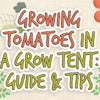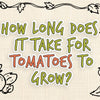15 Tips For Growing Tomatoes Every Gardener Needs To Know
Solanum Lycopersicum, commonly referred to as tomato, is the most popular fruit with at least 150 million tons produced every year. This popularity can be attributed to its broad applicability from sauces, juices and most commonly as a ‘vegetable’ granted that it’s actually a fruit. Tomatoes were initially grown by the Aztecs and were introduced to Europe by Spanish explorers.
Even with such a massive global production, it is nearly impossible to find freshly grown tomatoes as the majority of the produce in grocery stores is from large scale farms abroad whereby all sorts of agrochemicals are used especially pesticides. The only way to avoid the risks that such compounds cause is by growing your own tomatoes (link).

To get a better understanding of how to grow this marvellous fruit, we will look at the following tips:
1. Sunlight
Tomatoes require at least 8 hours of sunlight every day. Why so much sunlight? Well due to its fast-growing cycle the plant usually has immense energy requirements. This, in turn, calls for maximum photosynthesis which requires sunlight (link).
The most optimal sunlight for your tomato plants is in the morning and evening due to the higher ultraviolet concentration without the adverse heat that is usually witnessed during the midday sun. For this reason, ensure that your plants get maximum sunlight with a combination of both morning and late afternoon sunlight. During the midday, you can provide shading to protect your plants from the harmful rays.
Interested in learning more specifically about how much sun tomatoes require? Check out our post here (link).
2. Soil
Tomatoes do best in loam soils but will still grow in sandy loam soils. Prepare the beds by mixing the soil with well-rotted manure. Alternatively, you can use seaweed or poultry manure pellets to enrich the soil even further.
Apart from growing them on the ground soil (if it's rich enough) tomatoes also grow well in grow bags and pots. If you are to grow them in confined spaces such as pots ensure that they are at least 40 liters in capacity to provide enough room for root development. Otherwise, the restricted root space will prevent the plants from achieving optimum maturity (link).
3. Fertilizer
A growing tomato plant requires a constant supply of nitrogen, phosphates, and potash. These play a crucial role in cell regeneration as well as accelerating the growth of leaves and later on flowers. While these nutrients can be naturally found in the soil, the concentration isn’t enough for the rapidly growing plants.
For this reason, you must apply fertilizers; these come in various forms the most recommended for tomatoes being the 5-10-10 mix which contains 5 parts nitrogen, 10 parts potash, and 10 parts phosphate. The reduced nitrogen concentration is because tomatoes tend to uptake the nutrient in such vast amounts that the plant becomes merely too leafy thus hindering the growth of strong stems and reducing the number of flowers (link).
4. Time of The Year to Plant
Being a sub-tropical plant, they require full sun exposure in order to grow to their full potential. Sow the seeds when the weather is getting warm. This allows the plants at least a month of growth in the seedling nursery before they are ready for transplanting.
5. Pruning
Pruning is the primary vegetation control methodology when it comes to tomatoes. Why should you prune? For starters pruning tomato suckers reduce the number of leafy parts thus reducing the amount of nutrients that go to such parts instead of into flowering parts. Pruning also helps to control disease and pests by removing dense leaf cover where pests usually take cover.
Having said that it’s essential to take note of a study at Iowa State University that was published in 2000 that showed that pruning suckers made a difference sometimes and not all the times especially not when it comes to the size of fruits (link). However, on an anecdotal level pruning should be considered as long as it’s done conservatively.
6. Ripening
The ripening of matured fruits is controlled by ethylene chemical produced by the fruit upon achieving maturity. If your tomatoes are taking too long to ripen, then it means something is delaying lycopene and carotene which are both initiated by ethylene production.
You can encourage ripening by ensuring that the fruits are in at optimum temperature of 70 to 75F. It is essential to note that ripening does not rely on sunlight, in fact, tomatoes mature much faster away from the hot sunshine (link).
7. Depth of Planting
When transplanting the young tomato shoots the most recommended depth of planting is to bury the majority of the stem almost to the same level as the first shoots but ensure that these leaves are not in contact with the soil. Planting tomatoes this deep encourages formation of new roots along the buried stem for increased water and nutrition uptake.
Before transplanting the seedlings it is crucial to harden them for at least a week. To accomplish this, expose the seedlings to the external conditions for a few hours per day (gradually increase the number of hours). Also, reduce the amount of water given each time, this will help the young plant overcome the outdoors conditions much more smoothly without any noticeable decline in the growth trajectory (link).
8. Area to Plant
Before you transplant your tomato seedlings from the nursery, you need to prepare the garden. Part of this involves selecting the perfect location for the garden. Always go for a site with well-drained soil and access to full sun (link).
The site should also have ample space for your plants to grow and extra space to set up some sort of support system. The preparation stage should include digging the ground for at least 1 foot and mixing the soil with aged manure/compost.
9. Correct Spacing
Tomatoes should be planted at least 2 feet apart. This extra room allows the individual plans to grow freely and prevent the vines from intertwining. The individual rows should be at least 4 feet apart. This makes it possible to set up support systems for the plants along the rows without having to upset the sensitive roots (link).
With such ample spacing, you will also be free to move around the garden while performing maintenance work and it also discourages the growth of weeds. The spacing will also come in handy if one plant gets infected the chances of the disease spreading to nearby plants are reduced if there’s actual gapping.
10. Temperature
Tomatoes being sub-tropical plants require a warm environment in order to grow to their full potential. Sow the seeds when the weather is getting warm. This allows the plants at least a month of growth in the seedling nursery before they are ready for transplanting. Not sure if it's too cold to plant? The US and Canada climates are divided into 10 zones based on the average temperatures. One being the most chilled and ten being the hottest. Tomatoes are designated as zone 4 and 5 plants for optimum growth (link).
In the UK where warmth and sunlight are at a premium even in mid-summer, you should consider a raised position such as against a wall or in raised beds to give the plants a better chance of success. However, in the cooler parts such as Ireland you are better off growing your tomatoes undercover such as in a polytunnel or a greenhouse. Go ahead and look up your zone as the more you know about your local conditions, the more precise choices you can make.
11. Watering
Water not only plays a critical role in nutrition absorption through the roots but it’s also the transport agent in the plant via active osmosis. It's therefore essential that this vital fluid is always available for your plants (link).
It is recommended to water the plants early in the morning; this ensures that the plant has enough water and that the excess water will evaporate away during the day instead of clogging the soil. Always avoid splashing water onto the leaves and fruits as this will affect their growth, water gently around the base of the plant. This also encourages root growth.
One of the most common problems with watering is not knowing how much is enough. The best way to determine this is by inspecting the soil, poke a stick into the soil and examine how well the moisture has soaked in, however, don’t poke around near the base of the plant as you will injure the roots. Another telling feature would be the presence of run-away water, avoid such cases as that’s just wastage and can also lead to leaching of vital minerals from the soil.
Mulching increases soil moisture retention by preventing direct exposure to the elements. When appropriately applied mulch will play an essential role in weed control as well as preventing erosion. Some varieties of mulch such as cedar and pinewood chips repel gnat fleas and ticks from invading your garden. However, when using inorganic mulch, you should be on the lookout for inorganic molecules which might end up getting absorbed by the plant only to end up in your body. These include dyes and other nanoparticles.
12. Support
Tomatoes undergo robust growth within the first 2 months, for this reason, it's recommended that you start support training as early as possible. You can either use sticks or just pieces of string, twine the main stem with knots 8 inches apart.
Knots should be loosely tied to grant room for expansion; in fact, it's recommended to use single-strand twine as its much softer on the stem. The string should then be attached to height supports. Alternatively, you can use straight sticks firmly anchored on the base near the plant to train it.
13. Harvesting Tip
Harvesting each fruit the moment it ripens ensures that you have a constant supply of tomatoes. This also ensures that indeterminate tomato plants keep on flowering and setting new fruits throughout the summer. Harvesting on time also prevents losses that might occur when the fruits over ripen and fall off the storks as well as rotting (link).
14. Avoiding Disease
All manner of diseases afflicts tomatoes from fungal to bacterial and even viral infections. So much so that it would take an entire article to go through each of these diseases and disorders. However, the majority of these can be prevented and even eliminated if detected during the early onset stage. Some conditions such as bacterial wilt can only be controlled via crop rotation.
Others such as fungal early blight are best dealt with by pruning all infected parts and disposing of them in garbage pits away from the garden. If a disease rapidly spreads and threatens to spoil the entire harvest its recommended to switch commercial fungicides/ insecticides but only under the directions of a qualified agricultural specialist.
However, such actions should just be taken when non-invasive techniques fail to work; otherwise, you will be consuming the very chemicals you sort to avoid when settling on growing your tomatoes.
15. Avoiding Rotting
Tomatoes are super sensitive fruits. As a result, the fruits may rot due to various factors. Providing consistent conditions however will combat rot. This can be in terms of maintaining consistent moisture levels through frequent watering, applying mulch and maintain a soil pH of near 6.5.
Blossom end rot is characterized by leathery patches on the underside of the tomato fruits which progresses to rotten spots. This condition is caused by lack of calcium as the fruits swell. To prevent this, apply foliar spray with a calcium-magnesium solution or calcium acetate.
Interested In Growing Tomatoes?

At grow your pantry we have developed the perfect tomato cage. It's strong, multitiered, supports growth through all stages, strong and sturdy.
[Check Out The Latest Price Here]
Other Articles You'll Love...
15 Tips For Growing Tomatoes
What Causes Tomato Leaves To Curl?
How Much Sun Do Tomatoes Need?
Why Are My Tomatoes Not Turning Red?
How Far Apart To Plant Tomatoes
Why Are My Tomatoes Splitting?
-
Posted in
tomatoes







The best website I’ve come across for the tomato grower. Excellent info. tips and advice for me in the UK. Well done & thank you.